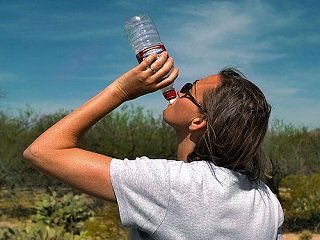 When the temperature increases, an enjoyably challenging hike can quickly turn into a tiresome trudge, especially if you’re not prepared for the heat. Knowing how your body reacts to such rises in temperatures, and planning ahead for it, will help prevent discomfort, fatigue, and dehydration before they set in. Keep reading for a few tips on how you can spend more time enjoying the trail and less time resting and bumming water off your well-prepared friends.
When the temperature increases, an enjoyably challenging hike can quickly turn into a tiresome trudge, especially if you’re not prepared for the heat. Knowing how your body reacts to such rises in temperatures, and planning ahead for it, will help prevent discomfort, fatigue, and dehydration before they set in. Keep reading for a few tips on how you can spend more time enjoying the trail and less time resting and bumming water off your well-prepared friends.
Many people drink only when they’re thirsty on a hike. This is one of the quickest ways to become dehydrated. While this will feel helpful, it actually only refreshes your immediate thirst, and will not replace vital fluids that are lost on long, humid days. The rule of thumb, when it comes to packing water, generally advises that you pack between 2 and 6 liters of water per person, per day, or at least 1 to 1 ½ liters an hour. Furthermore, it’s important to understand that water alone won’t do the trick. This is where replenishing electrolytes by consuming the right amounts of sodium and potassium is vital. To satisfy your body’s need for such nutrients, try to ingest at least 150 mg of sodium and 50 mg potassium each hour. Do not drink carbonated drinks to rehydrate, as they contain far too much sugar and not nearly enough salt to do the job.
It’s been a long day and you haven’t really paid much attention to how much you’ve had to drink. Now you’re starting to feel dizzy or weak, or any number of things as a result. If you are experiencing slight confusion, rapid pulse, weakness, nausea, or a headache, then odds are you have heat exhaustion, and need to rest and drink a significant amount of liquid and find some salty foods to replenish your electrolytes. Other, minor but equally uncomfortable symptoms can occur as a result of the heat, such as sharp pains in your legs and stomach. These are known as heat cramps, which are a result of a sudden decrease in your salt levels. Massaging the affected areas and increasing your salt intake will help. If your symptoms include severe confusion, vomiting, shortness of breath, or a red rash on your chest, then there’s a strong chance you’re suffering from heat stroke and you should seek immediate medical aid.
Sometimes it can be difficult to carry as much water as is required for your trip’s length. This is where it might be a good idea to look into filters and purifiers. I always have water purification tablets on me when I hike, just in case of an emergency. Also, portable purifiying systems, such as the Katadyn Vario or the Sawyer 3-Way Inline filters are great gadgets to have with you. Many filters available today remove harmful particles of 0.1 microns in size.
The best way to battle heat stroke or dehydration is to simply prepare yourself for the worst and drink often while hiking, even if you’re not thirsty. In extreme heat, it doesn’t take long for your body to react and the results of this can mean disaster if you don’t stay mindful of both the heat and your hydration levels. If you’re able to, pack more water than you need, and look out for each other on the trail. After all, that’s what friends are for.








